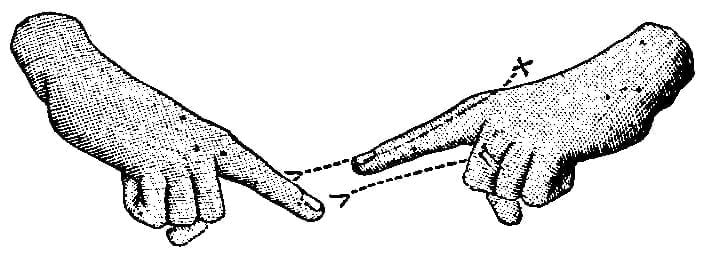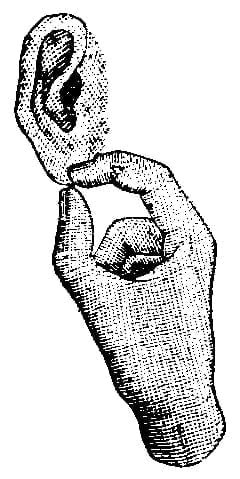Absaroka or Crow
The hands held out each side, and striking the air in the manner of flying. (Long.)
Imitate the flapping of the bird’s wings with the two hands, palms downward, brought close to the shoulder. (Burton.)
Imitate the flapping of a bird’s wings with the two hands, palms to the front and brought close to the shoulder. (Creel.)
Place the flat hand as high as and in front or to the side of the right shoulder, move it up and down, the motion occurring at the wrist. For more thorough representation both hands are sometimes employed. (Arapaho II; Cheyenne V; Dakota V, VI, VIII; Ponka II; Kaiowa I; Pani I; Comanche III; Apache II; Wichita II.) “Bird’s wing.”
Both hands extended, with fingers joined (W), held near the shoulders, and flapped to represent the wings of a crow. (Dakota II, III.)
At the height of the shoulders and a foot outward from them, move the upright hands forward and backward twice or three times from the wrist, palms forward, fingers and thumbs extended and separated a little; then place the back or the palm of the upright opened right hand against the upper part of the forehead; or half close the fingers, placing the end of the thumb against the ends of the fore and middle fingers, and then place the back of the hand against the forehead. This sign is also made by the Arapahos. (Dakota IV.) “To imitate the flying of a bird, and also indicate the manner in which the Absaroka wear their hair.”
Make with the arms the motion of flapping wings. (KutineI.)
The flat right hand, palm outward to the front and right, is held in front of the right shoulder, and quickly waved back and forth a few times. When made for the information of one ignorant of the common sign, both hands are used, and the hands are moved outward from the body, though still near the shoulder. (Shoshoni and Banak I.) “Wings, i.e., of a crow.” Fig. 281.

Apache
Make either of the signs for Poor, In Property, by rubbing the index back and forth over the extended left forefinger; or, by passing the extended index alternately along the upper and lower sides of the extended left forefinger from tip to base. (Kaiowa I; Comanche III; Apache II; Wichita II.) Fig. 282. “It is said that when the first Apache came to the region they now occupy he was asked who or what he was, and not understanding the language he merely made the sign for poor, which expressed his condition.”

Rub the back of the extended left forefinger from end to end with the extended index. (Comanche II; Ute I.) “Poor, poverty-stricken.”
Coyotero
Place the back of the right hand near the end of the foot, the fingers curved upward, to represent the turned-up toes of the moccasins. (Pima and Papago I;Apache I.) Fig. 283.

Mescalero
Same sign as for Lipan q.v. (Kaiowa I; Comanche III; Apache II; Wichita II.)
Warm Spring
Hand curved (Y, more flexed) and laid on its back on top of the foot (moccasins much curved up at toe); then draw hands up legs to near knee, and cut off with edges of hands (boot tops). (Apache III.) “Those who wear booted moccasins with turn-up toes.”
Arapaho
The fingers of one hand touch the breast in different parts, to indicate the tattooing of that part in points. (Long.)
Seize the nose with the thumb and forefinger. (Randolph B. Marcy, captain United States Army, in The Prairie Traveler. New York, 1859, p. 215.)
Rub the right side of the nose with the forefinger: some call this tribe the “Smellers,” and make their sign consist of seizing the nose with the thumb and forefinger. (Burton.)
Finger to side of nose. (Macgowan.)
Touch the left breast, thus implying what they call themselves, viz: the “Good Hearts.” (Arapaho I.)
Rub the side of the extended index against the right side of the nose. (Arapaho II; Cheyenne V; Kaiowa I; Comanche III; Apache II; Wichita II.)
Hold the left hand, palm down, and fingers extended; then with the right hand, fingers extended, palm inward and thumb up, make a sudden stroke from left to right across the back of the fingers of the left hand, as if cutting them off. (Sac, Fox, and Kickapoo I.) This is believed to be an error of the authority, and should apply to the Cheyenne tribal sign.
Join the ends of the fingers (the thumb included) of the right hand, and, pointing toward the heart near the chest, throw the hand forward and to the right once, twice, or many times, through an arc of about six inches. (Dakota IV.) “Some say they use this sign because these Indians tattoo their breasts.”
Collect the fingers and thumb of the right hand to a point, and tap the tips upon the left breast briskly. (Comanche II; Ute I.) “Goodhearted.” It was stated by members of the various tribes at Washington, in 1880, that this sign is used to designate the Northern Arapahos, while that in which the index rubs against or passes upward alongside of the nose refers to the Southern Arapahos.
Another: Close the right hand, leaving the index only extended; then rub it up and down, held vertically, against the side of the nose where it joins the cheek. (Comanche II; Ute I.)
The fingers and thumb of the right hand, are brought to a point, and tapped upon the right side of the breast. (Shoshoni and BanakI.)
Arikara (Corruptly abbreviated Ree)
Imitate the manner of shelling corn, holding the left hand stationary, the shelling being done with the right. (Creel.) Fig. 284.

With the right hand closed, curve the thumb and index, join their tips so as to form a circle, and place to the lobe of the ear. (Absaroka I; Hidatsa I.) “Big ear-rings.” Fig. 285.

Both hands, fists, (B, except thumbs) in front of body, backs looking toward the sides of the body, thumbs obliquely upward, left hand stationary, the backs of the fingers of the two hands touching, carry the right thumb forward and backward at the inner side of the left thumb and without moving the hand from the left, in imitation of the act of shelling corn. (Dakota I, VII, VIII.)
Collect the fingers and thumb of the right hand nearly to a point, and make a tattooing or dotting motion toward the upper portion of the cheek. This is the old sign, and was used by them previous to the adoption of the more modern one representing “corn-eaters.” (Arikara I.)
Place the back of the closed right hand transversely before the mouth, and rotate it forward and backward several times. This gesture may be accompanied, as it sometimes is, by a motion of the jaws as if eating, to illustrate more fully the meaning of the rotation of the fist. (Kaiowa I; Comanche III; Wichita II; Apache I.) “Corn-eater; eating corn from the ear.”
Signified by the same motions with the thumbs and forefingers that are used in shelling corn. The dwarf Ree (Arikara) corn is their peculiar possession, which their tradition says was given to them by a superior being, who led them to the Missouri River and instructed them how to plant it. (Rev. C.L. Hall, in The Missionary Herald, April, 1880.) “They are the corn-shellers.” Have seen this sign used by the Arikaras as a tribal designation. (Dakota II.)
Assinaboin
Hands in front of abdomen, horizontal, backs outward, ends of fingers pointing toward one another, separated and arched (H), then, moved up and down and from side to side as though covering a corpulent body. This sign is also used to indicate the Gros Ventres of the Prairie or Atsina. (Dakota I.)
Make the sign of cutting the throat. (Kutine I.) As the Assinaboins belong to the Dakotan stock, the sign generally given for the Sioux may be used for them also.
With the right hand flattened, form a curve by passing it from the top of the chest to the pubis, the fingers pointing to the left, and the back forward. (Shoshoni and Banak I.) “Big bellies.”
